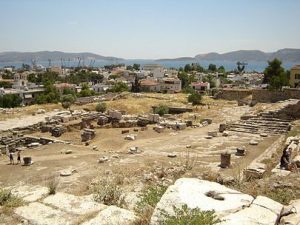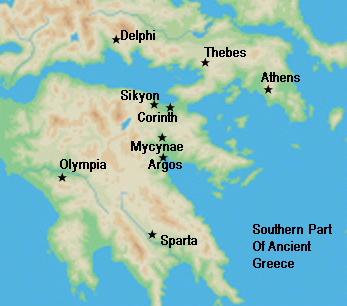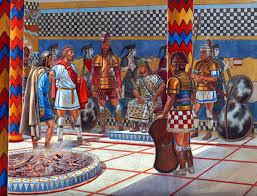Ancient Greek Thebes: In the Archaic as well as the Classical periods which is in the late 6th century BC, the Thebans were brought for the first time into an aggressive contact with the Athenians, who helped the small village of Plataea to maintain its independence against them, and in 506 BC repelled an inroad into Attica.

Subsequently, in the Peloponnesian War the Thebans, disillusioned by the support which Athens gave to the smaller Boeotian towns, and especially to Plataea, which they vainly attempted to reduce in 431 BC, were firm allies of Sparta, which in turn helped them to besiege Plataea and allowed them to destroy the town after its capture in 427 BC.
Ancient Greek Thebes vs Sparta
In 424 BC at the head of the Boeotian levy they inflicted a severe defeat upon an invading force of Athenians at the Battle of Delium, and for the first time displayed the effects of that firm military organization which eventually raised them to predominant power in Greece. After the downfall of Athens at the end of the Peloponnesian War, the Thebans became aware that Sparta intended to protect the states which they desired to annex, broke off their alliance.

In 404 BC they had urged the complete destruction of Athens, yet in 403 BC they secretly supported the restoration of its democracy in order to find in it a counterpoise against Sparta. In the early Byzantine period, Thebes played the role as a place of refuge against foreign invaders.
From the 10th century onwards, Thebes became a center of the new silk trade. The silk workshops got a tremendous boost from Greek imports of soaps and dyes from Athens. The growth of this trade in Thebes continued to such an extent that by the middle of the 12th century, the city had become the biggest producer of silks in the entire Byzantine Empire, surpassing even the Byzantine capital, Constantinople.

The women of Ancient Greek Thebes became well known for their skills at weaving. Theban silk won numerous prizes for both its quality as well as for its excellent reputation. Additionally, in spite of being severely plundered by the Normans in 1146, Thebes quickly recovered its prosperity and continued to grow rapidly until the final dissolution of the Byzantine Empire by the Fourth Crusade which came about in 1204.
Today, Ancient Greek Thebes stands as a bustling market town, well known for a variety of products and wares. Until the 1980s it had a flourishing agrarian production with some industrial complexes. However, it was only during the late 1980s and 1990s that the bulk of industry moved further south, closer to Athens.

Tourism in the area is based mainly in Thebes and the surrounding villages, where a lot of places of interest related to antiquity exist like for instance the place where the Battle of Plataea took place but it is still in an infant state and has ample scope for further growth. However, the proximity to other, more famous travel destinations, like Mount Athens and Chalkis, and the less developed prospect stands as one of the biggest archaeological sites in Greece to have kept the tourist numbers low.
Thebes Greece Government
As recent as in 2011, the municipality of Thebes formed the local government by the merger of the following 4 former municipalities namely Thebes, This, Vagia and Plataies.